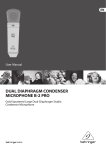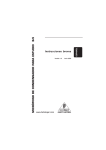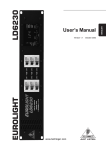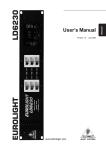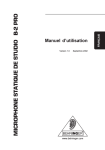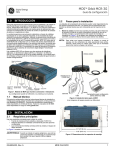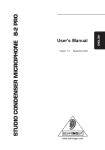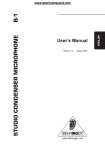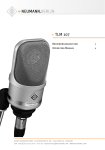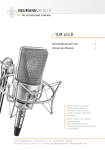Download Behringer Microphone B-5 User's Manual
Transcript
User Manual SINGLE DIAPHRAGM CONDENSER MICROPHONE B-5 Gold-Sputtered Large-Diaphragm Studio Condenser Microphone behringer.com 2 SINGLE DIAPHRAGM CONDENSER MICROPHONE B-5 User Manual Important Safety Instructions Terminals marked with this symbol carry electrical current of sufficient magnitude to constitute risk of electric shock. Use only high-quality commercially-available speaker cables with ¼" TS plugs pre-installed. All other installation or modification should be performed only by qualified personnel. This symbol, wherever it appears, alerts you to the presence of uninsulated dangerous voltage inside the enclosure - voltage that may be sufficient to constitute a risk of shock. This symbol, wherever it appears, alerts you to important operating and maintenance instructions in the accompanying literature. Please read the manual. Caution Condenser microphones are extremely moisture-sensitive. Never use your microphone in close proximity to water (e.g. bath tubs, wash basins, sinks, washing machines, pools, etc.). When doing voice recordings, always use the enclosed popscreen to safely protect the capsule from moisture. Caution Always use the power supply specified in the operating instructions. Caution Take care not to drop your microphone as this can lead to severe damage. BEHRINGER assumes no liability for any damage caused by the user. After each use, remove the microphone from its mount and wipe it down with a soft cloth and place it back into its protective casing (included with the microphone). Then, lay the small bag containing the moisture-absorbing crystals on top of the microphone head. Limited Warranty Please register your new BEHRINGER equipment right after your purchase by visiting behringer.com and read the terms and conditions of our warranty carefully. 3 SINGLE DIAPHRAGM CONDENSER MICROPHONE B-5 User Manual 1. Power Supply Phantom power (+48 V) is required to operate your microphone. We assume no liability for damage caused to your B-5 through deffective phantom power. Before activating phantom power, mute your playback system and connect the B-5 to the microphone input of your mixing console. After activating phantom power, the B-5 requires several seconds to stabilize itself. 2. Pickup Patterns Your B-5 was delivered with two capsules allowing different pickup patterns: cardioid ( ) and omnidirectional ( ). If you use the cardioid pattern capsule, the pickup pattern is such that the sound produced by sources located in front of the mic is strongly picked up, while sound sources to the side are picked up less pronouncedly. Therefore, the cardioid pattern capsule is ideal for directional pickup of acoustic instruments. It is often used in recording situations in which several sound sources are present. Since this capsule selectively tones down the pickup of sounds located to the side of the microphone, this way you can achieve good separation of sound sources, thus easily avoiding feedback. The so-called proximity effect is typical for microphones with the cardioid pickup pattern. Depending on the distance between the microphone and the sound source, a slight increase in the lower frequency range occurs. The shorter the distance, the more pronounced this effect. By cleverly selecting the position and the angle of your microphone, you can effectively manipulate the proximity effect and thus affect how your recording sounds. Experiment with various positions in order to gain more experience. The proximity effect does not occur with the capsule featuring the omnidirectional pickup pattern; its strength is its ultra-linear frequency response. With this pickup pattern, your B-5 picks up a large portion of diffuse ambience sound and is therefore particularly well suited for atmospherical, natural-sounding recordings. Similarly, you can also use the omnidirectional pickup pattern capsule in situations in which several sound sources (e. g. a group of singers) need to be picked up together. 4 SINGLE DIAPHRAGM CONDENSER MICROPHONE B-5 User Manual 3. Low Cut-Filter and Level Attenuation (-10 dB) The B-5 features a switchable low-cut filter that eliminates low-frequency noise such as floor rumble. Set the switch to its middle position to activate the low-cut filter. For situations in which the microphone is exposed to extremely high sound pressure levels, the B-5 features a switchable level attenuation (“pad”). When the switch is in its “-10 dB” position, the level attenuation is activated. When the switch is in its top-most position, the signal is not influenced in any way. 4. Microphone Installation To properly attach your microphone to a microphone stand, a clamp is included. First screw this clamp onto your stand before attaching the microphone itself. 5. Changing Microphone Capsules When your B-5 leaves the assembly plant, it has the cardioid pickup pattern capsule screwed onto its shaft. To loosen the capsule, hold the shaft firmly and unscrew the capsule turning it counter-clockwise. ◊ When installing a capsule, please make sure to handle both the capsule and the microphone shaft with attention and care to avoid damaging the screw thread. In no situation should you ever apply excessive force. 6. Audio Connection To connect the B-5 to your equipment, use a balanced XLR microphone cable with the following pin assignment: Pin 1 = shielding, pin 2 = +, pin 3 = -. Since all contact points of the B-5 are gold-plated, your microphone cable too should feature gold-plated connectors, if possible. 5 SINGLE DIAPHRAGM CONDENSER MICROPHONE B-5 User Manual 7. Level Setting/Adjusting the Basic Sound Adjust the gain control in the microphone channel of your mixing console so that the peak LED lights up only occasionally or never at all. The EQ controls in the microphone channel should be set to mid-travel position to start with; low-cut filter and level attenuation should be off. Try to achieve the desired sound by experimenting with the microphone position. Often, it will be useful to set up acoustic barriers (“baffles”) at various angles towards the signal source. Only when the desired basic sound has been achieved, should you start using equalizers and signal processors, if any at all. Remember: less is often more! 0 dB 330˚ 0˚ -5 dB 30˚ -10 dB 300˚ 60˚ -15 dB -20 dB -25 dB -30 dB 270˚ 90˚ 240˚ 120˚ 210˚ 150˚ 250 Hz 500 Hz 1000 Hz 2000 Hz 180˚ 4000 Hz 8000 Hz 16000 Hz Polar pattern (cardioid) dB 20.0 10.0 0.0 -10.0 -20.0 Low cut 50.0 100.0 Frequency response (cardioid) 1000.0 10k 15k 20k Hz 6 SINGLE DIAPHRAGM CONDENSER MICROPHONE B-5 User Manual 0 dB 330˚ -5 dB -10 dB 300˚ -15 dB 270˚ 240˚ 210˚ 250 Hz 500 Hz 1000 Hz 2000 Hz 180˚ 4000 Hz 8000 Hz 16000 Hz Polar pattern (omnidirectional) dB 20.0 10.0 0.0 -10.0 -20.0 Low cut 50.0 100.0 Frequency response (omnidirectional) 1000.0 10k 15k 20k Hz 7 SINGLE DIAPHRAGM CONDENSER MICROPHONE B-5 User Manual 8. Specifications Transducer type true condenser, 18 mm (0.71") single diaphragm Operating Principle Cardioid pressure gradient Omnidirectional pressure operated Polar pattern 1 x cardioid 1 x omnidirectional, exchangeable Connection gold-plated, balanced XLR connector Open Circuit Sensitivity (at 1 kHz) Cardioid -38 dBV (0 dBV = 1 V/Pa), 12.6 mV/Pa Omnidirectional -40 dBV (0 dBV = 1 V/Pa), 10 mV/Pa Frequency response 20 Hz - 20 kHz Level attenuation -10 dB (switchable) Low-cut filter 6 dB/oct. at 150 Hz (switchable) Max. SPL (1% THD @ 1 kHz) 140 dB (0 dB) 150 dB (-10 dB) Equivalent SPL (IEC 651) 16 dB-A (cardioid) 18 dB-A (omnidir.) Signal-to-Noise Ratio Cardioid 78 dB A-weighted Omnidirectional 76 dB A-weighted Nominal impedance 70 Ω Load impedance >1 kΩ Supply voltage +48 V Supply current 3 mA Physical/Weight Dimensions Ø shaft: 20 mm Length 120 mm Weight approx. 0.21 lbs / 0.09 kg behringer.com









